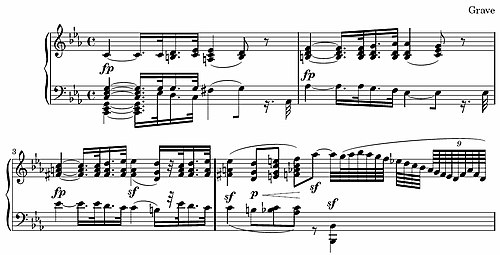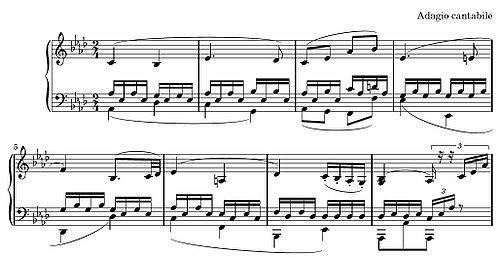Piano Sonata No. 8 (Beethoven): Difference between revisions
Undid revision 462783042 by 75.81.252.25 (talk): -WP:TRIVIA; moved sound out of lead. |
Wikipedia has no problem with "trivia" if it's ideally included in the main sections and there's no better place for this statement to go. And for this to be included in the Peanuts movie is very notable and should be included |
||
| Line 2: | Line 2: | ||
Prominent [[musicology|musicologists]] debate whether or not the ''Pathétique'' may have been inspired by [[Wolfgang Amadeus Mozart|Mozart]]'s [[Piano Sonata No. 14 (Mozart)|piano sonata K. 457]], since both compositions are in [[C minor]] and have three very similar movements. The second movement, "Adagio cantabile", especially, makes use of a [[Theme (music)|theme]] remarkably similar to that of the spacious second movement of Mozart's sonata.<ref>Marks, F. Helena. [http://www.archive.org/details/sonataitsformmea00markuoft ''The Sonata: Its Form and Meaning as Exemplified in the Piano Sonatas by Mozart'']. W. Reeves, London, 1921.</ref> However, Beethoven's sonata uses a unique [[Motif (music)|motif]] line throughout, a major difference from [[Joseph Haydn|Haydn]] or Mozart’s creation.<ref name= "AllAboutBeethoven" /> |
Prominent [[musicology|musicologists]] debate whether or not the ''Pathétique'' may have been inspired by [[Wolfgang Amadeus Mozart|Mozart]]'s [[Piano Sonata No. 14 (Mozart)|piano sonata K. 457]], since both compositions are in [[C minor]] and have three very similar movements. The second movement, "Adagio cantabile", especially, makes use of a [[Theme (music)|theme]] remarkably similar to that of the spacious second movement of Mozart's sonata.<ref>Marks, F. Helena. [http://www.archive.org/details/sonataitsformmea00markuoft ''The Sonata: Its Form and Meaning as Exemplified in the Piano Sonatas by Mozart'']. W. Reeves, London, 1921.</ref> However, Beethoven's sonata uses a unique [[Motif (music)|motif]] line throughout, a major difference from [[Joseph Haydn|Haydn]] or Mozart’s creation.<ref name= "AllAboutBeethoven" /> |
||
[[Schroeder]] plays the second movement of this piece during the first ''[[Peanuts]]'' movie, ''[[A Boy Named Charlie Brown]]''. |
|||
==Movements== |
==Movements== |
||
Revision as of 17:27, 28 November 2011
Ludwig van Beethoven's Piano Sonata No. 8 in C minor, Op. 13, commonly known as Sonata Pathétique, was written in 1798 when the composer was 27 years old, and was published in 1799. Beethoven dedicated the work to his friend Prince Karl von Lichnowsky.[1] Although commonly thought to be one of the few works to be named by the composer himself, it was actually named Grande sonate pathétique (to Beethoven's liking) by the publisher, who was impressed by the sonata's tragic sonorities.[2]
Prominent musicologists debate whether or not the Pathétique may have been inspired by Mozart's piano sonata K. 457, since both compositions are in C minor and have three very similar movements. The second movement, "Adagio cantabile", especially, makes use of a theme remarkably similar to that of the spacious second movement of Mozart's sonata.[3] However, Beethoven's sonata uses a unique motif line throughout, a major difference from Haydn or Mozart’s creation.[1]
Schroeder plays the second movement of this piece during the first Peanuts movie, A Boy Named Charlie Brown.
Movements
In its entirety, encompassing all three movements, the work takes approximately 19 minutes to perform.
The sonata has three movements:
- Grave (Slowly, with solemnity) – Allegro di molto e con brio (Quickly, with much vigour)
- Adagio cantabile (Slowly, in a singing style)
- Rondo: Allegro (Quickly)
Grave – Allegro di molto e con brio
The first movement is in sonata form. It begins with a slow introductory theme, marked Grave. The exposition, marked Allegro di molto con brio, is in 2/2 time (alla breve) in the home key of C minor and features three themes. Theme 1 features an aggressive rocket theme covering two octaves, accompanied with constant tremolo octaves in the left hand. Beethoven then makes use of unorthodox mode-mixture, as he presents the second theme in E-flat minor rather than its customary parallel major. This theme is more lyrical and makes use of grace notes and crossed hands. Theme 3 has modulated to the mediant, E-flat major, and features an Alberti-type figuration for the bass with tremolo. A codetta, with ideas from the opening allegro, closes the section. Some performers of the sonata include the introduction in the exposition repeat though others return to the beginning of the allegro section.
The development section begins in the key of G minor. In this section, Beethoven extends Haydn's compositional practice by returning to the introductory section. After this reappearance of the Grave, the composer generates suspense with an extended dominant preparation.
The recapitulation brings back the themes of the exposition in different keys: themes 1 and 3 are played in the tonic key of C minor, then theme 2 is played in the unexpected key of F minor but then returns to the tonic key. The coda is very dramatic and includes a brief reminder of the Grave before ending with a swift cadence.
MIDI rendition, 6:57 minutes, 30 KB |

Adagio cantabile
The Adagio movement opens with a famous cantabile melody. This theme is played three times, always in A-flat major, separated by two modulating episodes. The first episode is set in F minor (relative to A-flat major), further modulating to E-flat major before returning to the main theme. The second episode begins in A-flat minor and modulates to E major. With the final return of the main theme, the accompaniment becomes richer and takes on the triplet rhythm of the second episode. There is a brief coda.
MIDI rendition, 5:03 minutes, 12 KB |

Rondo: Allegro
The sonata closes with a cut time movement in C minor. The main theme closely resembles the second theme of the Allegro of the first movement: its melodic pattern is identical for its first four notes, and its rhythmic pattern for the first eight. There is also a modified representation of the melody from the second movement, thus connecting all three movements together. The movement's sonata rondo form includes a coda. The three rondo episodes are in E-flat major, A-flat major, and C major. The movement can be thought as related to Beethoven Concerto No. 3 in C minor Op.37. The common use of sforzando creates a forceful effect.
MIDI rendition, 4:25 minutes, 17 KB |

See also
References
- ^ a b Beethoven Pathetique Sonata Op. 13 All About Beethoven. Retrieved May 1, 2008.
- ^ Burkhart, Charles: Anthology for Musical Analysis, page 233. Schirmer 2004.
- ^ Marks, F. Helena. The Sonata: Its Form and Meaning as Exemplified in the Piano Sonatas by Mozart. W. Reeves, London, 1921.
External links
- A lecture by András Schiff on Beethoven's piano sonata op. 13
- Score from the Ricordi edition, William and Gayle Cook Music Library at the Indiana University School of Music.
- Score and MIDI files from Mutopia Project in several formats
- Video - Adagio cantabile from Sonata No. 8, Op.13 performed by Christine Kwong at the Bavarian Academy of Music, Hammelburg, Germany
- Brief analysis of the Sonata Pathétique and free score on the All About Ludwig van Beethoven pages
- Public-domain recording of this sonata at Musopen
- Free scores by Piano Sonata No. 8 at the International Music Score Library Project (IMSLP)
- Analysis of the sonata on Wikilivres

